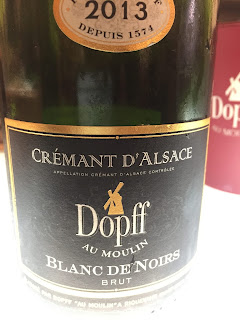Now that Stages 1 & 2 of my Cremant tour de France are complete, I celebrated Stage 3 by tasting my way through the Cremants of Alsace, in person!
Located on the eastern border with Germany, Alsace contains 15,621 hectares of vineyards. (Source: backinalsace.com). Approximately 23.3% of grapes harvested from the vineyards are used to make Cremant d'Alsace bubbly. In 2017, 32,125 bottles of Cremant wine were made, 80% of which remained in France due to domestic demand!
Our first stop along our tasting journey was Domaine Klipfel, in the small town of Barr.
The estate was founded in 1824 by Martin Klipfel. In 1830, he procured the prestigious Clos Zisser vineyard, which is used today for their Vendage Tardive (late-harvest) and Selection de Grains Nobles (grapes affected by "Noble Rot", botrytis, made into lusciously sweet dessert-style wines). Klipfel crafts their Cremants in the Methode Traditionelle style, using Chardonnay and Pinot Noir either as single-varietal bottles, or a mix of the two.
Klipfel's Blanc de Noirs Cremant d'Alsace opens up with a nose of green apples and continues into a palate of lemon zest and steely minerality. The bubbles were aggressive up front, but settled down into a creamy mousse mid-palate, leading into a clean finish.
I am all about the high quality and the unique, sometimes extraordinary quality that comes from smaller, lesser-known producers. Located in the small Alsatian town of Heiligenstein, Domaine J.L. Schwartz lives up to this quality!
Our tasting at J.L Schwartz started off with their Cremant d'Alsace Brut Rose. A lively bouquet composed of strawberries and navel oranges, intertwines with refreshing acidity and delicate mousse on the palate to create a delightful mouthfeel. Unfortunately, the finish dropped off rather quickly, but it did make me want to take more sips quicker to compensate!
The standout Cremant of the day for both my husband and I was the Brut Chardonnay! The varietal's flavour profile is well represented here, with an intriguing blend of underripe banana and navel oranges along with stony minerality. There is a lively mouthfeel that doesn't overpower, full of delicate mousse and refreshing acidity. Very elegant in style, and very approachable!
Our day of Cremant tasting ended at Domaine Julien Dopff au Moulin. Regarded as one of the pioneers of Cremant d'Alsace, Julien Dopff attended the Universal Exhibition in Paris in 1900, where he learned about "Methode Champenoise". He made it his mission to experiment with Alsatian varietals, and Dopff au Moulin now dedicates a considerable amount of their wine portfolio to Cremant d'Alsace bubbly.
The Dopff au Moulin Rose expresses more autolytic notes than other Cremants d'Alsace I have tasted. But it doesn't overpower the abundant flavours of underripe red fruit on the palate, the creamy mousse, or the bright acidity. Very well-structured and refreshing!
Finally, the 2013 Blanc de Noirs Brut marries notes of dried red fruit and toasted almonds with crisp acidity and aggressive, but not off-putting mousse. Very elegant in style, and very food-friendly.
Cremant d'Alsace offers a variety of sparkling wine created in the Methode Traditionelle, yet can also express a wide array of flavour profiles. There are many excellent Cremants available throughout the world, and even though only 20% of all bottles are exported, you will likely find a variety of Cremants available in your local wine stores.
Stay tuned as I wrap up my Cremant Tour de France later this month with Cremant de Bourgogne!














